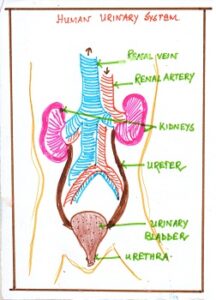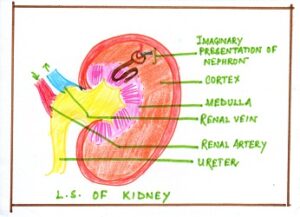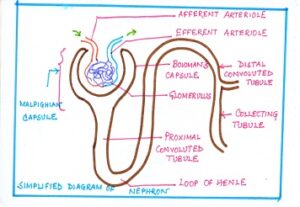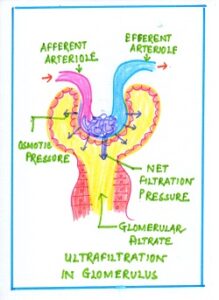HUMAN EXCRETORY SYSTEM
INTRODUCTION:-
Various waste products are formed in our body as a result of many
metabolic activities taking place inside the body. These waste substances if
accumulated would poison cells or slow down their metabolism. Hence, the body must
get rid of these unwanted substances.The metabolic wastes to be excreted include
CO2, H2O, fat, ammonia, urea and uric acid. (EXCRETION SYSTEM)
The nourishment coming from food that is simplified or processed by digestion is consumed by the blood and conveyed all through the body. When this absorbed food is broken down in the tissues and many toxic and poisonous substances are produced which should be removed as they may be fatal if present beyond a certain concentration. The removal of these substances is known as excretion. Excretion and osmoregulation, both are interconnected processes and occur side by side. in higher vertebrates like humans, kidneys perform both the functions, excretion as well as osmoregulation.The system responsible for these function is known as the excretory system or urinary system
DEFINITION
1)Excretion: It is the removal of metabolic waste from the body. (EXCRETION SYSTEM)
2) Osmoregulation: It is the process by which the water content and ion concentration are regulated in the cells. By this, the osmotic pressure (thrust) of blood is kept constant. (balanced) (EXCRETION SYSTEM)
VARIOUS EXCRETORY ORGANS: ( EXCRETION SYSTEM)
Humans possess a number of excretory organs like skin, lungs, liver and kidneys. Skin,
lungs and liver are considered as accessory excretory organs while Kidneys are the
most important excretory organs.
| TYPE OF EXCRETORY ORGAN | EXCRETORY PRODUCTS | SPECIALITY |
| 1)SKIN | *salts
*water *some ions |
Here excretory products pass out through the ducts of glands and pores |
| 2)SWEAT GLAND | *dissolved salts like sodium chloride
*lactic acid *traces of urea *amino acids *glucose |
Sweat flows out from the sweat gland ducts on the surface of the skin |
| 3)SEBACEOUS GLAND | *wax-like secretion containing lipids, sterols, fatty acids, hydrocarbon
( EXCRETION SYSTEM)
|
These are secreted out through the ducts on the surface of the skin |
| 4)LUNGS | *carbon dioxide
*water vapour |
These are removed by way of expiration. |
| 5)LIVER | *bile pigment-containing biliverdin and bilirubin | Removed along with faeces. |
| 6)LIVER | *cholesterol
*products of complex hormones *alcohol *nicotine *drugs *urea formed by the reation of ammonia with CO2 |
Removed along with faeces |
| 7)KIDNEYS | *urea
*other nitrogenous waste |
Eliminated through urine. ( EXCRETION SYSTEM) |
HUMAN EXCRETORY SYSTEM

The excretory system in human beings consists of the following parts: ( EXCRETION SYSTEM)
* Kidneys
* ureters
* urinary bladder
*urethra
KIDNEYS:

The Kidneys are ruddy dark colored or dark pink in coloured, a combined structure that lie along the backside of the stomach on either side of the vertebral column section. They are protected by the last two pairs of ribs (floating ribs). The shape of the kidney is of bean seed with a length of 10 cm, breadth of 6 cm and with the thickness of 4 cm. The right kidney is situated somewhat lower than the left kidney as the correct side of the stomach hole is occupied by the liver. They are held in position by padding. On the inner side of the concave or curved side of the kidney is present a
notch or ridge which is called hilum. It is the place from where the ureter and the renal vein come out and the renal artery enters to kidney.
URETERS:-
The ureters arise from within the renal sinus of the kidneys at hilum. The anterior part of each ureter is a funnel-shaped structure, the renal pelvis. The ureters passes urine from the kidneys to the urinary bladder.
Each ureter opens obliquely in the urinary bladder by a slit-like aperture to prevent
back flow of the urine.
URINARY BLADDER:- ( EXCRETION SYSTEM)
The urinary bladder acts as a muscular reservoir for storage of urine. It lies inside the pelvic cavity of the abdomen. The opening or neck of the urinary bladder is surrounded by sphincter muscles which act like a valve which remain closed until the time of micturition (urination). In an adult, the average capacily of the urinary bladder varies from 150 mL to 300 ml.
URETHRA:-
The urethra is membranous tube that arises from the neck of the urinary bladder and extends up to the urethral orifice. In male it serves as a common passage from urine and sperms. Urethra in females serves as an exit for pee in particular..
MICTURITION :- It is the act of voiding the urine. The urine is carried by peristaltic wave down ureter. The waves originates in a pace makerat the renal end of the ureter. The ureter pass obliquely through the thick muscular wallof the bladder. Accumulation of urine in the bladder raises its pressure, and aspontaneous reflex is initiated. As the smooth muscles of the bladder wall contract, the urethral sphincter muscles relax, evacuating the urine. Urinedoes not flow back during contraction of bladder to ureters as theureters pass obliquely and their terminal
parts get closed during contraction. Micturition may be initiated or delayed voluntarily.
INTERNAL STRUCTUREOF KIDNEY
 Each Kidney consists of two distinct regions – an outer part which is renal cortex and an inner region which is known as renal medulla The medulla is subdivided into 15 or 16 conical masses, the renal pyramids. Each pyramid has narrow renal papilla towards the pelvis and a broad base toward the cortex. Renal papillae open into a wide funnel-like structure, renal pelvis. The renal pelvis in turn leads into the ureter.
Each Kidney consists of two distinct regions – an outer part which is renal cortex and an inner region which is known as renal medulla The medulla is subdivided into 15 or 16 conical masses, the renal pyramids. Each pyramid has narrow renal papilla towards the pelvis and a broad base toward the cortex. Renal papillae open into a wide funnel-like structure, renal pelvis. The renal pelvis in turn leads into the ureter.
Each kidney contains endless filtering or seiving units called nephrons. A kidney may have more than 1.2 million nephrons.. Every nephron starts to originate in the cortex area and widely stretches out into the medulla region distinctly. In a kidney, the renal supply route divides to split into various arterioles and vessels, for the maximum part in the cortex.The capillaries coil and form little, knot like structures called glomeruli. Each glomerulus is almost completely surrounded by a cup-shaped structure called bowman’s capsule which leads into coiled tubules. The tubule after a progressive series of loops and coliis( curls and circles), joins different tubules and goes through the medulla and opens into the renal pelvis at the zenith of a pyramid.
PHYSIOLOGY OF URINE FORMATION ( EXCRETION SYSTEM)
Pee development (preparation of urine) includes three primary procedures: ultrafiltration, cylindrical reabsorption and rounded emission.
STEPS ARE: ( EXCRETION SYSTEM)
1)Blood from renal artery enters kidneys through afferent arteriole

2)ULTRAFILTRATION: Blood enters glomerulur capillaries. Water and small solutes are filtered in Bowman’s capsule.
3)TUBULAR REABSORPTION: Water and many solutes are reabsorbed through the wall of nephric tubule and return to the blood in particular capillaries.
4)Tubular secretion: Cells of renal tubule remove wastes from blood and pass then into the filtrate.
5)Hormonal action adjusts the urine concentration ADH promotes water reabsorption. Aldosterone influences reabsorption of sodium and potassium. ( EXCRETION SYSTEM)

6)Urination: Water and solutes flow to renal pelvis, then eliminated out through urinary tract.
An adult man normally passes about 1-1.8 litres of urine in 24 hours. Urine is a transparent yellowish fluid. Its yellow colour is due to a pigment urochrome derived from the breakdown of haemoglobin of worn out RBCs.
Its pH ranges from 6-8. It has an unpleasant odour. If allowed to stand, the urea present in it, is degraded by bacteria to ammonia, which gives a strong awful smell to it.